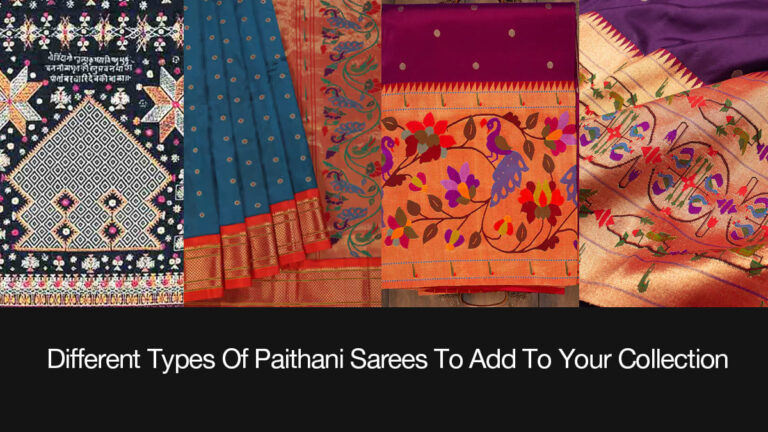Whether it’s for everyday or special occasions, the quintessential saree fits into every dress code with ease. This is not even its best part! The fact that this Indian-origin silhouette has several variations is what blows our minds each time. From North to South, almost every state has its own version of the drape, all equally awe-worthy. In this blog post, we’ll be focusing on just one of the many stunning types – the Paithani. While the types of paithani saree are many, there remains one constant; they’re all luxurious and hold immense significance in Maharashtrian culture.
Originating from Aurangabad, Maharashtra, a Paithani saree is a sight to behold, and so is the woman wearing it. The royal dynasties of Paithan loved this masterpiece and so did the brides! Evolving with the same cultural significance, it is also called the Queen of Sarees by some. Employing pure silk threads and silver zari, it is a brocade saree that is fully handcrafted with traditional tapestry techniques. Although it’s on the higher side of the price scale, it is worth every penny! Let’s delve into the reasons behind it.
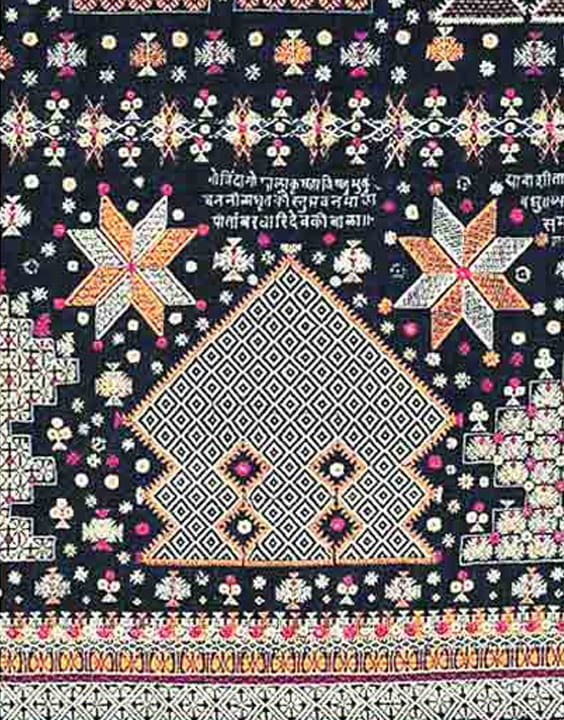
What is special in paithani saree?
A code for ‘royalty’ back in the day, the Paithani now plays a huge role in every Maharashtrian wedding. Ask a Maharashtrian bride-to-be or the mother of the bride about the significance of the Paithani and you’re sure to receive a soul-satisfying response! Paithani is a treasure to own and behold, & is hence passed down from one generation to another to keep its legacy alive. The best part about types of Paithani saree is that it is almost identical on both sides and dazzles in the sunshine or the spotlight. Making the wearer look absolutely radiant thanks to its stunning palette and effervescent appeal, this saree is woven tightly in Maharashtrian culture.
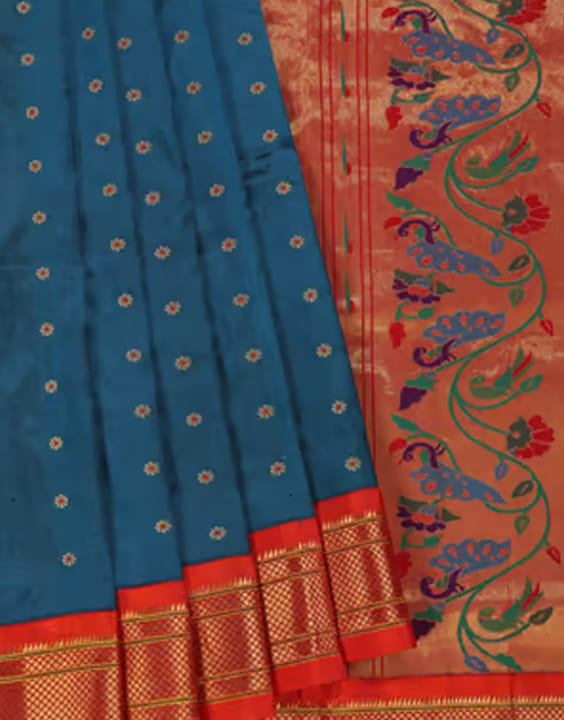
How can we identify pure Paithani?
While real Paithani is made with pure silk and zari, the rising demand for low-priced sarees has also given birth to mock alternatives that resemble this masterpiece but are far from it. While some salesmen are quite straightforward about this some may even try to fool a first-time Paithani buyer. This is why it is necessary to know how to identify a non-genuine drape before you go ahead and buy yourself one.
The key to differentiating between a pure and blended Paithani is to know the design elements. Paithani is a handwoven silk saree with rich Zari threadwork of either gold or silver along the pallu and borders. What sets the various types of Paithani sarees apart from the rest is the unique weaving technique that is employed. The entire process from yarn dyeing to weaving is done by hand by expert artisans in India. Handlooms are used to weave the main body of the saree. The silk that is used to make these sarees is extremely fine & delicate.
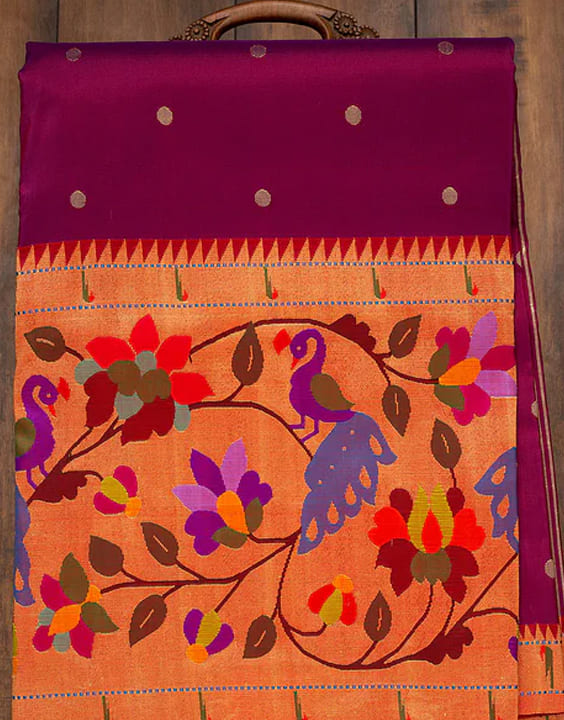
The design and motif creating process are also unusual. They are made by interlocking & tying the colourful threads to the warp on the loom. As we mentioned before, the reverse side of the fabric and designer is nearly identical to its top side. These patterns, quite literally seem as if they were inlaid into the fabric itself.
No two Paithani sarees look the same. Similar, yes, but not the same since they’re made by hand. This leaves room for significant differences. The same is not the case for counterfeit Paithani designs are they are mass-produced and therefore, are the same. Another way to differentiate real from fake is to look at the reverse side of the handloom saree, specifically the pallu. The reverse side of the original one looks exactly the same as its top side.
Since a real Paithani saree uses natural dyes and colours along with silver and gold zari threads it is considerably heavy and requires extreme care and cautiousness. The cheaper, machine-made alternatives? Not so much.
Mass-produced types of Paithani sarees are manufactured in less than 15 days, whereas genuine ones take months or even a year depending on the design.
Which colour Paithani is best?
A Paithani saree is known for its unique blend of colours and motifs. People from all over the world come to India and take home beautiful Paithani drapes for keepsakes. If you’re one of them, you need to know the colours this saree is popular for. The most significant tints are kali chandrakala (jet black saree with a red border), Raghu (parrot green colour), and Shirodak (pure white).
Types Of Paithani Sarees With Images
There is an array of paithani saree types one can choose from! A saree connoisseur will most likely go for the ones that are the most treasurable out of the lot. Here we take a look at the various interpretations of this age-old masterpiece that falls under the finest types of silk sarees.
Bangdi Mor Paithani Saree
Different types of sarees in India are known for their motifs inspired by nature and depicted through prints, embroidery, or other mediums. Keeping this in mind, these Paithani Saree Types are also adorned with peacock motifs while introducing an essential jewellery element, the bangle, a.k.a ‘Bangdi’ in Marathi. They come together to form a peacock woven in the shape of a bangle.
It is said to be one of the most difficult motifs to weave and rightly so. With a gold zari tissue temple border and authentic mor bangdi motifs – four peacocks inside a bangle, this is one of the oldest types. The gold zari tissue pallu showcases colourful akruti motifs of flowers, peacocks and mor bangdi, in addition to muniya motifs.
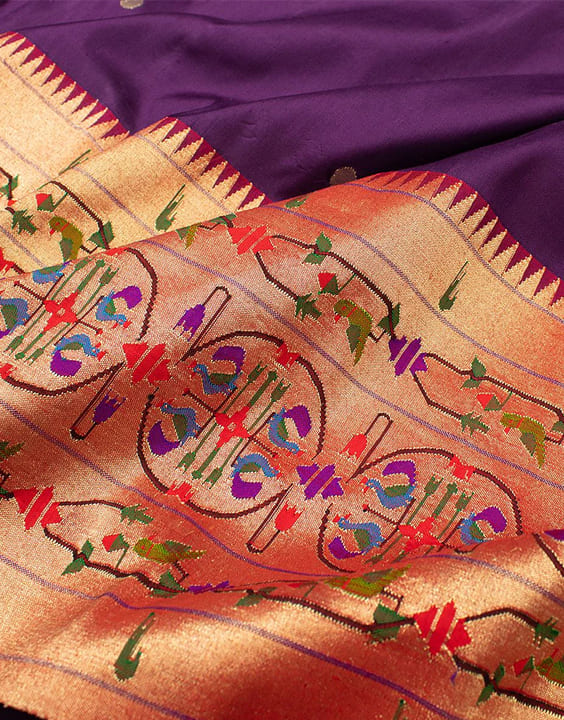
Ekdhoti Weave Paithani Saree
The weaving of this saree is quite awe-inspiring and you would agree. A single shuttle is used for the weaving of the weft. The colour of the warp yarn is not the same as that of the weft yarn. These types of Paithani sarees have a narali border and also simple butti designs like coins or peas.
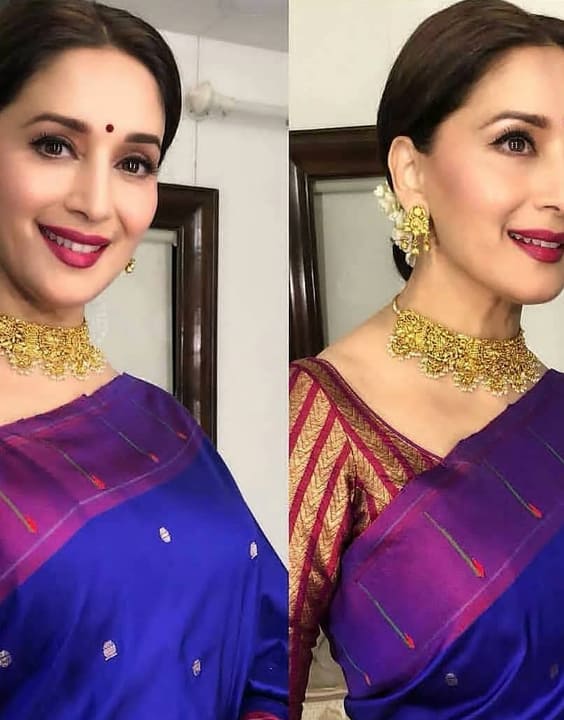
Brocade Paithani
Patterned and woven, brocade is one of the richest fabrics. Unlike embroidered fabrics, brocade patterns are woven into the fabric. Brocade has a longstanding history of creating the perfect Banarasi saree look, and it has been made use of in various cultures. While traditionally, brocade was reserved for more ornamental purposes, with the rising awareness and curiosity among millennials and Gen Z it is now quite commonly used.
When it comes to brocade Paithani, the border of the saree is adorned with this stunning and ostentatious fabric. More intricate work has higher price points and less tedious work can be found at lower price points. However, the saree still remains on the expensive side due to the craftsmanship and materials used.

Munia Brocade Paithani
Stints with nature as the muse are quite common among Indian designers and artisan communities. Like Bangdi Mor, the Munia Brocade Paithani also employs a similar nature-inspired approach. With “Munia” translating to parrot in Marathi, this saree sees motifs of the infamous bird woven on the pallu and the border too. Usually leaf green, they are also locally known as “tota-maina”.
Detailed motifs can take months to complete, and that’s another reason why this saree falls on the expensive side. The green accents lend a sophisticated and cultural appeal, rendering one speechless upon a single glance!
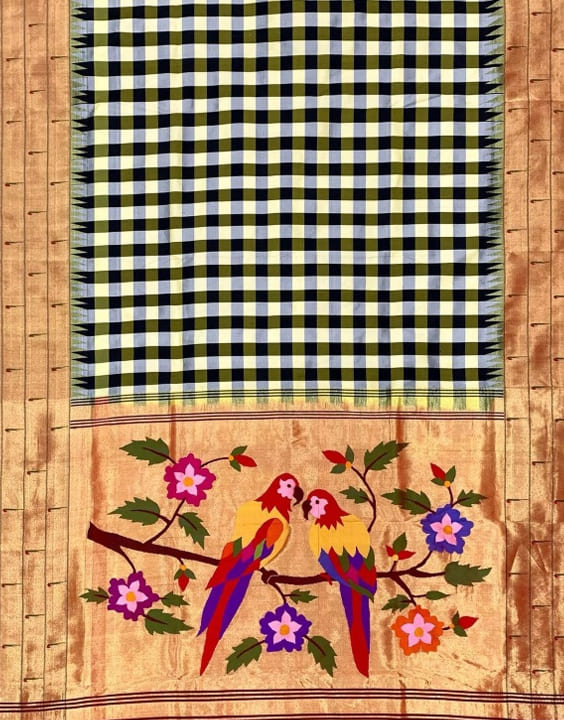
Tracing Its History
Weaving different types of Paithani sarees is over 2000 years old tradition and dates back to the Satvahana Dynasty. They say that this craft has its roots in a city called ‘Pratishtan’, now called Paithan. It falls in Marathwada about 50 km from Aurangabad.
At that time, Pratishtan used to be a trade centre for silk & zari, & also exported cotton, and silk to the Roman Empire. The name of Paithani can be credited to this city.
Around the 17th Century, the Mughal emperor, Aurangzeb also encouraged & patronized the art of weaving Paithani. The ‘Aurangzebi’ designs were developed just for him and are popular even to date. The Great Madhavrao Peshwe carried the tradition of Paithani forward even after the Mughals.
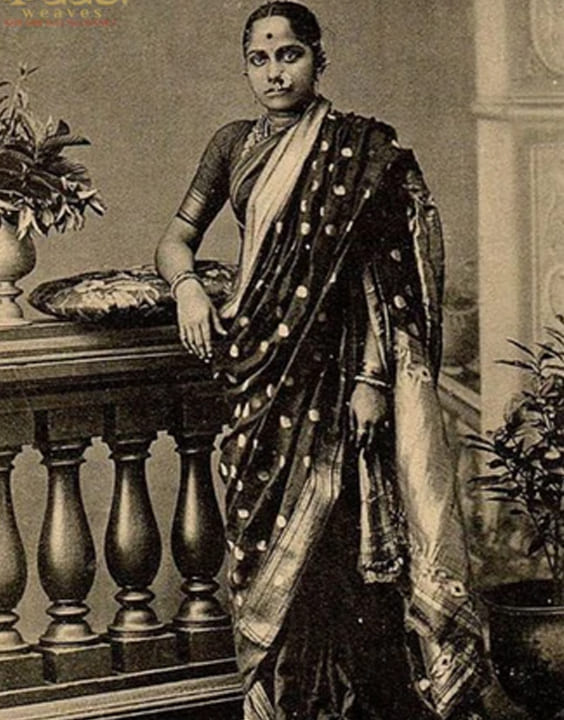
It was the Peshwas who encouraged a sense of pride in Paithani among Maharashtrians.
Later, the Nizam of Hyderabad became an admirer of Paithani and special motifs were made for them. But with the birth of the British Raj, Paithani saw a setback. The weavers from Yeola kept the art alive by developing their own techniques. Gradually, the artisans from Paithan also migrated to Yeola. It is because of this dedication shown by the weavers that this craft is still alive and has been for the past several years.
Fast-forward to the current day, Yeola is now the main centre for Paithani weaving.
How Is Paithani Made
The first step in the making of different types of Paithani saree involves weaving the pallu with silk warp or with zari. This step takes up the maximum amount of time because it is highly intricate. The saree itself is known for its complex details and opulent borders.
The pallu takes anywhere from 2 days to 2 weeks to be finished. Only highly-skilled artisans are hired to weave the pallu to perfection.
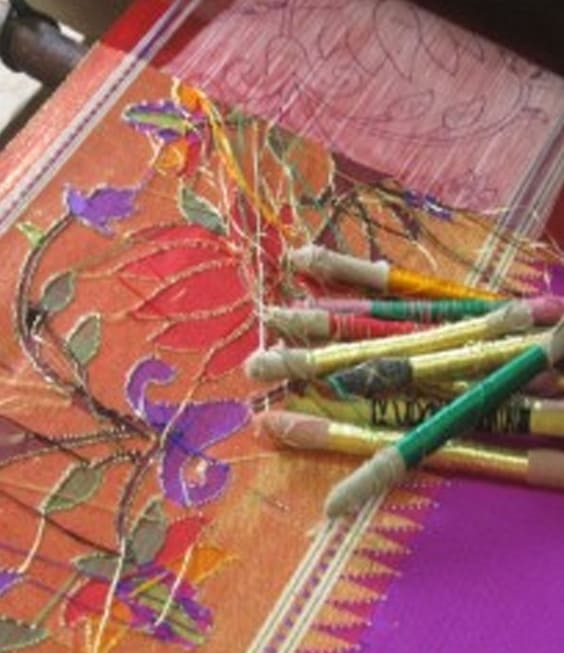
The body of the saree is woven next, with standout borders on both sides. The designs are almost always present but the weaver himself can integrate unique elements if he makes sure that the thread count remains the same. Handling the bana and tana is also a highly important step of the process.
On the completion of every 3 to 4 inches of the body, a mixture made of gum and water is used in order to polish the zari and keep it stiff. It is aimed at sealing loose threads. Primarily, sticky substances like gum, jaggery, etc., are used for polishing, along with an assortment of other ingredients that don’t leave a stain on the fabric.
Caring For Paithani Saree
Types of Paithani saree are extremely delicate due to the use of pure silk and zari. To make them last, there are a few things you must do. Here’s how to care for your Paithani and give it the love & looking-after that it deserves.
- To avoid dust patches and other external damage, it’s always best to store the Paithani saree wrapped in a Muslin cloth.
- Avoid using naphthalene balls or any kind of chemicals.
- Spill any liquids on your Paithani saree are a strict no-no.
- Never use a plastic or a regular cardboard box to store the saree.
- Ensure good air circulation when the saree is in storage.
- Do change its folds after each use.
- Protect it from damp conditions, especially during monsoons.
India’s saree heritage is world famous. Even though now there are over a hundred variations of the drape, the classic styles still remain embedded in the hearts and closets of all Indian women. If you are someone who enjoys the drape thoroughly, don’t forget to invest in different types of Paithani sarees. Need some styling inspiration? Look at some prominent Bollywood actresses in the saree!
Also Read On: How to wear a saree

